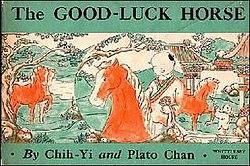 First edition | |
| Author | Chih-Yi |
|---|---|
| Illustrator | Plato Chan |
| Cover artist | Chan |
| Language | English |
| Genre | Children's picture book |
| Publisher | Whittlesey House |
Publication date | 1943 |
| Publication place | United States |
The Good-Luck Horse is a children's picture book illustrated by Plato Chan, adapted from a folk tale by his mother Chih-yi Chan. Plato Chan was the son of a Chinese diplomat and a child prodigy; he was twelve when he illustrated the book. [1] The Good-Luck Horse was published by Whittlesey House in 1943. It was a 1944 Caldecott Medal honoree. [2] [3] This story has adventures of a horse that a boy had made out of paper and then changed into a real horse by a magician. He was named the good-luck horse because his fortunes fell and rose. Plato Chan (March 14, 1930-January 18, 2006) and wife Anne Chu Chan (September 17, 1928-October 28, 2010) are buried at the Family of G.A. Cu Unjieng Mausoleum Manila Chinese Cemetery .
Contents
